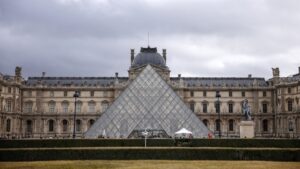
There are no official government statistics on the percentage of Ukrainian citizens who use cryptocurrencies as of December 2025. In practice, estimates from analytical companies and the results of sociological surveys are used, but the figures vary significantly due to different definitions of “use” (ownership, investment experience, real transactions, transfers).
The most frequently cited estimate for the entire country is data from Triple-A: “15.72% of Ukrainians own cryptocurrency,” which is equivalent to approximately 6.5 million people (estimate of the share of the total population).
Survey data gives higher values for certain population groups. For example, a Gradus Research study commissioned by WhiteBIT (April 2024) among residents of cities with a population of 100,000 or more (aged 18-60, 883 respondents, excluding temporarily occupied territories and areas of active hostilities) showed that 26% of respondents reported owning cryptocurrencies.
Another benchmark is an Ipsos study commissioned by WhiteBIT (April-May 2025) among “financially active” city dwellers aged 18-65 (650 respondents in cities with a population of 100,000 or more). The published results indicate that 25% already had experience investing in cryptocurrency, while another 23% stated their intention to start in the near future. At the same time, a note on the methodology indicates the composition of the sample, which included, in particular, respondents who do not reject investing in cryptocurrency and those who already keep part of their savings in cryptocurrency. This is important to consider when interpreting the results as an indicator of the “financially active” audience, rather than the entire population.
If we interpret “use” as strictly as possible — as personally conducting transactions — then the Gradus study gave a more “conservative” lower limit: 5.1% of respondents reported that they had personally conducted transactions with crypto assets and/or blockchain (the same material separately noted a much higher proportion of experience in the 18-24 age group).
Chainalysis indirectly confirms Ukraine’s high level of involvement: in the Global Crypto Adoption Index 2025, Ukraine ranked first in the rating adjusted for population (and eighth in the overall rating), with the calculation taking into account the assessment of transaction flows and web traffic of crypto services.
The spread of estimates in 2024-2025 (from approximately 15-16% “ownership” to about a quarter in selected urban and “financially active” samples) is explained by the fact that ownership/investment experience is usually broader than the proportion of people who regularly use crypto assets in real transactions.
In the public legal field of Ukraine, virtual assets are not considered a legal means of payment – the text of the law “On Virtual Assets” explicitly states that virtual assets are not a means of payment on the territory of Ukraine and cannot be exchanged for goods, works, and services.
Financial regulators have also emphasized that cryptocurrencies do not fall under the regime of money/electronic money/currency values as interpreted by Ukrainian legislation and have pointed out the risks of transactions with them.
https://www.fixygen.ua/news/20251219/priblizno-16-ukrayintsiv-volodiyut-kriptoaktivami.html

In September 2025, there was an annual peak in the granting of temporary status to Ukrainian citizens in European Union countries, according to Eurostat.
“In October 2025, EU countries issued 74,175 new decisions on granting temporary protection. This is the second highest monthly figure in 2025 after the peak recorded in September (79,525). These high figures are the result of a decree by the Ukrainian government, adopted at the end of August 2025, which grants men aged 18 to 22 inclusive the right to leave Ukraine without hindrance,” the report says.
As of October 31, 2025, Ukrainian citizens accounted for more than 98.4% of those who received temporary protection in the EU. Adult women accounted for 43.8% of those who received temporary protection. Minors accounted for almost a third (30.8%), and adult men for just over a quarter (25.5%) of the total number
. As of October 31, 2025, a total of 4.3 million non-EU citizens who fled Ukraine had temporary protection status in the EU. Compared to the end of September 2025, the total number of persons from Ukraine under temporary protection decreased by 6,170 (-0.1%).
The EU countries that received the largest number of persons from Ukraine under temporary protection were Germany (1,229,960 persons; 28.6% of the total number in the EU), Poland (965,005; 22.5%), and the Czech Republic (393,005; 9.1%).
CZECH REPUBLIC, GERMANY, POLAND, TEMPORARY PROTECTION, UKRAINIANS

The number of Ukrainians planning Christmas and New Year shopping has increased over the year from 65% to 75%, despite the fourth year of full-scale war, according to Deloitte Ukraine’s “Holiday Shopping 2025” survey, provided by the company’s press service.
“This year, we see that preparations for the holidays are becoming more thoughtful and forward-looking: Ukrainians are planning their purchases earlier, approaching spending more cautiously, and more often choosing things that have personal significance for them and their loved ones. For 51% of respondents, the process of preparing gifts remains a pleasant ritual rather than a source of stress. Such familiar concerns help us today to support ourselves and those around us,” notes Alexander Yampolsky, head of retail and wholesale distribution at Deloitte Ukraine.
However, according to the survey results, more and more Ukrainians are also choosing to celebrate at home—68% compared to 54% in 2024. More and more Ukrainians are starting their holiday shopping early: 18% before December, while the main shopping period is December 1-24 (62%).
For the fourth year in a row, Ukrainians are not increasing their spending: 46% are willing to spend no more than a quarter of their monthly income on shopping, and 54% plan to spend between UAH 1,000 and UAH 5,000, with holiday purchases focused on family (88%) and friends (40%). At the same time, young people are more likely to deviate from the traditional scenario: 49% buy gifts for themselves.
Ukrainians most often do their holiday shopping in large and medium-sized supermarket chains (43%), with online stores consistently ranking second (27%) and cosmetics stores (21%) remaining popular due to the demand for gifts “for themselves and their loved ones.”
The most popular tools for choosing gifts are wish lists (46%), price comparison services (54%), and online reviews (50%). Recommendations from influencers play a much smaller role, with only 9-10% of respondents relying on them. And only 10% of respondents believe that the presence of an AI assistant on retailers’ online platforms would make it easier to select holiday gifts.
It is emphasized that shoppers are most upset by the lack of available products (27%), excessive advertising (22%), and inconvenient search filters (14%).
At the same time, 64% of Ukrainians plan to allocate part of their holiday budget to charity, and 8 out of 10 primarily support Ukrainian defenders on the front lines.
“The holiday habits of Ukrainians reflect not only consumer trends, but also deeper internal changes. The way people give gifts, celebrate, and seek joy is now an important part of their emotional stability. Even during the war, Ukrainians remain a community that helps, shares, and creates a festive atmosphere for each other,” Yampolsky concluded.
The study was conducted using a multi-stage stratified sample representing the population of Ukraine by gender, age, size of settlement, and type of employment. Data was collected through an online survey using a quota sample that corresponds to the socio-demographic profile of the Ukrainian population. In total, more than 1,000 respondents took part in the survey.

Consumer priorities of Ukrainians have changed, since the beginning of the full-scale war, 47% of respondents have reduced spending on the main categories of consumption, according to the press service of Gradus.
At the same time, 85% noted that they try to maintain a mental balance, allowing themselves occasions for joy and pleasure. This trend is most pronounced in the 25-34 age group, while people 45-55 and 55+ years old are more inclined to save money.
Regarding methods of reducing spending, 82% avoid unnecessary things but do not deny themselves things that bring pleasure, 77% try to buy fewer things but better quality, 76% invest in health, 59% are willing to spend on things that improve emotional well-being and 52% direct funds to development and experience (study, travel).
Ukrainians consider health and medical services to be the most important item of expenditure that should not be saved on (70%).
As for expectations from fashion & beauty-brands – Ukrainians now put quality and durability of things in the first place (39%), and prestige – in the last place (11%).
As for luxury goods, the opinions of respondents are divided. Restraint in buying such things was reported by 32% of respondents. The answer options “it is an excess, which is out of time now” and “are not interested in luxury goods at all” were chosen by 22% and 18% respectively. At the same time, 19% of respondents called luxury goods “a component of normal life, which allows you not to lose yourself”.
In general, women are less inclined to reduce spending on most categories. The reluctance to save money on things that are important to themselves was reported by 61% of women and 47% of men, while goods that improve emotional well-being continue to be purchased by 70% of women and 50% of men.
The research “Consumer pragmatism: how the war has changed our consumption” was conducted by research company Gradus in partnership with Vogue Ukraine specially for the Forces Of Fashion 2025 conference, by self-completion of the questionnaire in the Gradus mobile application. Target audience: men and women aged 18-60 with an above average income, living in Ukrainian cities with a population of more than 50 thousand people, excluding temporarily occupied territories and zones of active hostilities. The field stage lasted from August 25-27, 2025. Sample size: 600 respondents.

The global ranking of armed populations, compiled on the basis of the Small Arms Survey, shows that the ten countries with the largest number of civilian weapons include the United States, India, China, Pakistan, Russia, Brazil, Mexico, Germany, Yemen, and Saudi Arabia. Ukraine is not on this list, but even before Russia’s full-scale invasion, the country was among the states with a significant amount of weapons in the hands of citizens. The Experts Club Analytical Center analyzed global and Ukrainian statistics.
According to the Small Arms Survey for 2017-18, there were about 4.4 million civilian weapons in Ukraine—approximately 9.9 guns per 100 inhabitants. Of these, only about 800,000 were officially registered, and about 3.6 million belonged to the illegal segment.
According to the National Police database, as of July 31, 2018, there were 892,854 registered weapons in the country. In 2021, the Ministry of Internal Affairs estimated the number of weapons legally owned by citizens at approximately 1.3 million, against the backdrop of tighter regulations and growing public interest in self-defense after 2014.

The full-scale war of 2022 dramatically changed the picture. Against the backdrop of the formation of territorial defense and volunteer units, the state massively transferred small arms to citizens; at the same time, a significant number of captured and illegal firearms ended up in the hands of the population. Estimates today vary widely: according to Interior Minister Ihor Klymenko, Ukrainians may have between 1 and 5 million weapons, while a number of think tanks put the figure at 4–5 million, of which 2–3 million may be in illegal circulation.
Research by Small Arms Survey using sociological surveys shows that up to 11% of Ukrainian households may have at least one weapon, which on a national scale gives a range of 865,000 to 1.42 million armed households. At the same time, the share of households that openly report the presence of weapons in 2023–2024 remains at 5–6%, which indicates both a high level of distrust and the sensitivity of the issue in wartime.
To bring order, Ukraine has launched a Unified Weapons Register. By July 2024, 63% of households that own weapons stated that some or all of their weapons were registered; among those who are aware of the system, 74% claim to have registered all their weapons, but about 10% continue to keep unregistered weapons.
Thus, while before the war there were approximately 1.3 million registered weapons in Ukraine and several times more illegal firearms, now, against the backdrop of full-scale hostilities, there are millions of weapons, a significant portion of which must gradually be registered or confiscated.
This makes the issue of civilian weapons control one of the key issues for post-war security, law enforcement reform, and Ukraine’s negotiations with the EU on the harmonization of weapons legislation.
Source: https://expertsclub.eu/ukrayina-na-tli-svitovogo-rynku-czyvilnoyi-zbroyi/

From the beginning of next year, the Louvre Museum in Paris will significantly increase the cost of admission tickets for most visitors from countries outside the European Union and the European Economic Area (EEA). This was reported by Euronews Serbia and the Serbian newspaper Politika, citing a decision by the museum’s board and BBC reports.
From 14 January 2026, tickets for tourists from countries outside the EU and the EEA (which, in addition to EU countries, includes Norway, Iceland and Liechtenstein) will increase in price from €22 to €32, i.e. by 45%.
The new rates will apply, in particular, to citizens of the United States, the United Kingdom, China, and all countries that are not members of the EU or the EEA – the countries of the Western Balkans (including Serbia, Montenegro, North Macedonia, Albania, Bosnia and Herzegovina), Ukraine, Russia, Turkey, the Middle East, Africa, Latin America and most of Asia.
According to the Louvre itself, the museum was visited by about 8.7 million people in 2024, of whom approximately 69% were foreign tourists; more than 10% of the flow was accounted for by US citizens, and about 6% by Chinese visitors. The French authorities and the museum’s management expect that the price increase for non-Europeans will bring in tens of millions of euros in additional revenue, which will be used to strengthen security and carry out a large-scale renovation of the building and exhibition spaces.